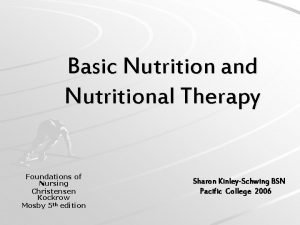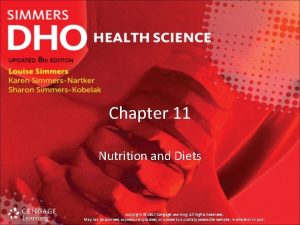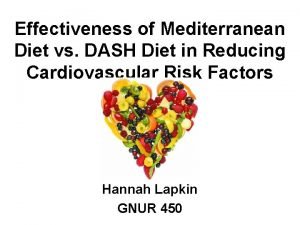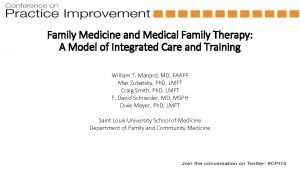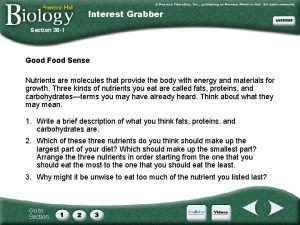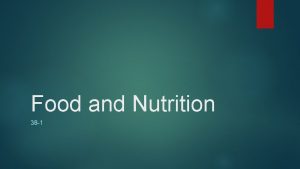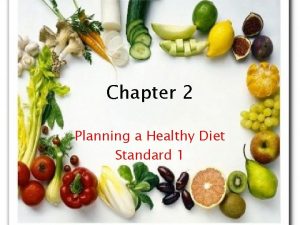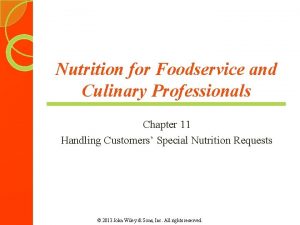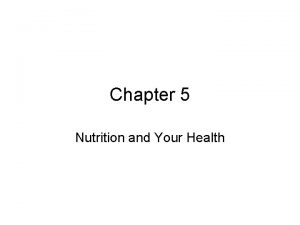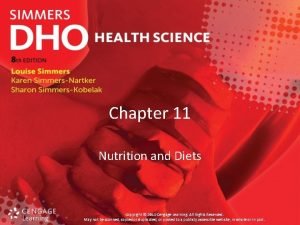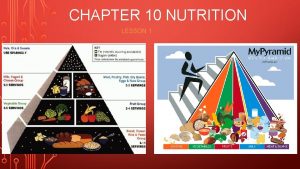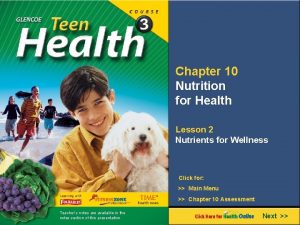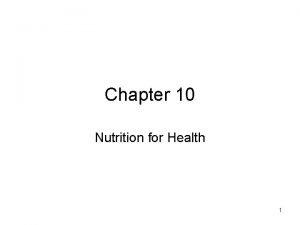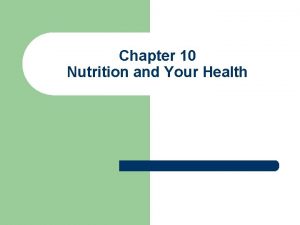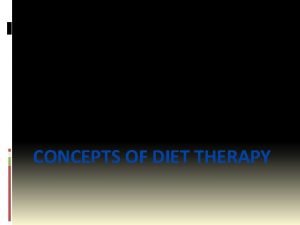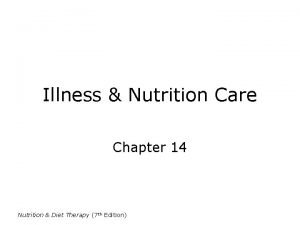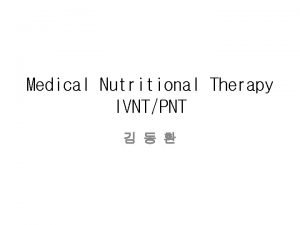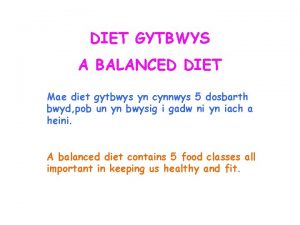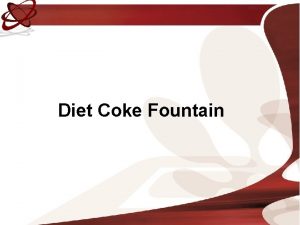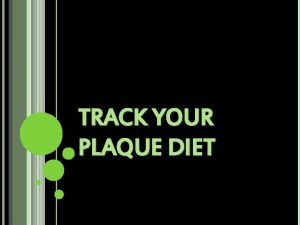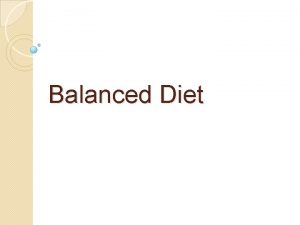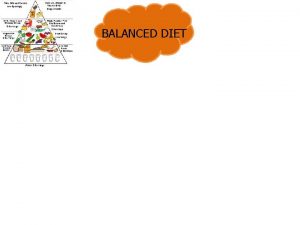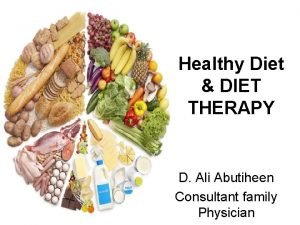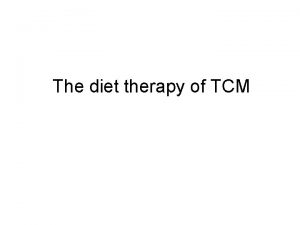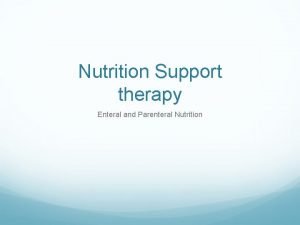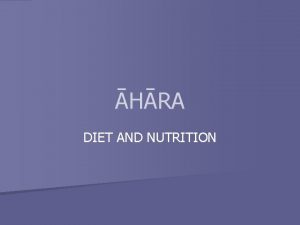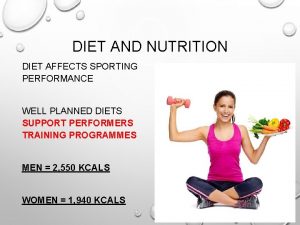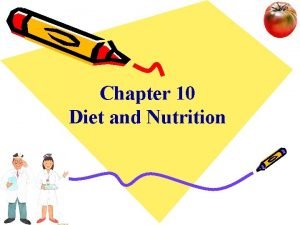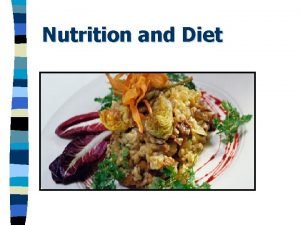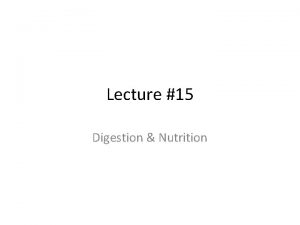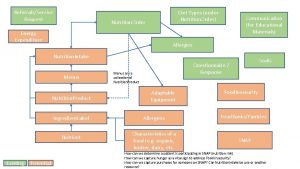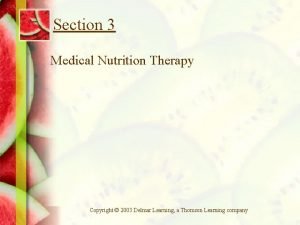Section 3 Medical Nutrition Therapy Chapter 21 Diet






























- Slides: 30

Section 3 Medical Nutrition Therapy

Chapter 21 Diet and Cancer

Objectives § § Chapter 21 Discuss how nutrition can be related to the development or the prevention of cancer State the effects of cancer on the nutritional status of the host Describe nutritional problems resulting from the medical treatment of cancer Describe nutritional therapy for cancer clients Copyright © 2003 Delmar Learning, a Thomson Learning company 3

Cancer is the second leading cause of death in the United States. It is a disease characterized by abnormal cell growth and can occur in any organ. Cancerous tumors are malignant, affecting the structure and consequently the function of organs. Chapter 21 Copyright © 2003 Delmar Learning, a Thomson Learning company 4

Cancer The mortality rate for cancer clients is high, but cancer does not always cause death. Oncology is the study of cancer. An Oncologist is a physician who specializes in cancer. Chapter 21 Copyright © 2003 Delmar Learning, a Thomson Learning company 5

Causes of Cancer Precise etiology of cancer unknown. Heredity, viruses, environmental carcinogens, and possibly emotional stress may contribute to its development. Cancer is not inherited, but some families appear to have a genetic predisposition for it. Chapter 21 Copyright © 2003 Delmar Learning, a Thomson Learning company 6

Causes of Cancer Environmental carcinogens include radiation (x-rays, sun, nuclear wastes), certain chemicals (ingested in food, water or touched by skin) and certain substances that are breathed in (tobacco smoke and asbestos). Carcinogens cause cancer after repeated exposure. Chapter 21 Copyright © 2003 Delmar Learning, a Thomson Learning company 7

Causes of Cancer Viruses linked to cancer: Epstein Barr, hepatitis B, and herpes simplex II. • • • Chapter 21 Epstein Barr: nasopharyngeal cancer, Tcell lymphoma, Hodgkin’s disease and gastric carcinoma Hepatitis B: liver cancer Herpes Simplex II: cervical and uterine cancer Copyright © 2003 Delmar Learning, a Thomson Learning company 8

Classifications of Cancer Majority of all cancers fall under these headings: carcinomas, sarcomas, lymphomas, and leukemias. Skin cancer is becoming more prevalent. There are three types of skin cancer: basal cell, squamous cell, and melanoma. Chapter 21 Copyright © 2003 Delmar Learning, a Thomson Learning company 9

Relationships of Food and Cancer Both good and bad relationships between food and cancer exist. Carcinogens include nitrates in cured and smoked foods such as bacon and ham. Regular ingestion associated with stomach and esophagus cancer. Chapter 21 Copyright © 2003 Delmar Learning, a Thomson Learning company 10

Relationships of Food and Cancer High-fat diets associated with uterine, breast, prostate, and colon cancers. Excessive caloric intake associated with gallbladder and endometrial cancer. Smoking and drinking alcohol associated with lung, mouth, pharynx, and esophagus cancer. Chapter 21 Copyright © 2003 Delmar Learning, a Thomson Learning company 11

Relationships of Food and Cancer Diets high in fiber help protect against colorectal cancer. Diets rich in vitamin C may protect against stomach and esophagus cancer. Diets high in vitamin A may protect against lung, bladder, and larynx cancer. Chapter 21 Copyright © 2003 Delmar Learning, a Thomson Learning company 12

Relationships of Food and Cancer Flavonoids, phenols, and indoles are phytochemicals. These are substances that occur naturally in plant foods and are thought to be anticarcinogenic. Eat five or more servings of fruits and vegetables each day. Chapter 21 Copyright © 2003 Delmar Learning, a Thomson Learning company 13

Relationships of Food and Cancer Legumes such as soybeans, dried beans, and lentils contain vitamins, minerals, protein, and fiber and may protect against cancer. High intakes of soy foods are associated with a decreased risk of breast and colon cancer. Chapter 21 Copyright © 2003 Delmar Learning, a Thomson Learning company 14

Relationships of Food and Cancer An immune system that has been damaged —possibly through malnutrition—may be a contributing factor in the development of cancer. Excessive protein and fat intake, however, may be a factor in the development of cancer of the colon. Chapter 21 Copyright © 2003 Delmar Learning, a Thomson Learning company 15

The Effects of Cancer Unexplained weight loss, weakness, anorexia. Loss of muscle tissue and hypoalbuminemia. Sense of taste and of smell becomes abnormal. Chapter 21 Copyright © 2003 Delmar Learning, a Thomson Learning company 16

The Effects of Cancer Satiated earlier than normal. Abnormal insulin production with hyperglycemia. Hypercalcemia, renal stones, impaired kidney function Cachexia: severe malnutrition and body wasting. Chapter 21 Copyright © 2003 Delmar Learning, a Thomson Learning company 17

Treatment of Cancer Surgical removal, radiation, chemotherapy, or a combination of these methods used to treat cancer. Side effects of these treatments can affect nutrition. These include xerostomia (dry mouth) and dysphagia (difficulty in swallowing). Chapter 21 Copyright © 2003 Delmar Learning, a Thomson Learning company 18

Treatment of Cancer Tooth decay and loss of teeth sometimes occurs. Radiation and chemotherapy may depress appetite. Anorexia (loss of appetite), nausea, vomiting, and diarrhea can lead to fluid and electrolyte imbalances. Chapter 21 Copyright © 2003 Delmar Learning, a Thomson Learning company 19

Nutritional Care Kcal needs of the cancer client are greater than before the illness. Clients on high-protein and high-kcal diets tolerate the side effects of therapy and higher doses of drugs better than those who cannot eat normally. Chapter 21 Copyright © 2003 Delmar Learning, a Thomson Learning company 20

Nutritional Care Clients can form aversions to food making anorexia worse. To help with aversions: • • Chapter 21 Hold chemotherapy 2 to 3 hours before and after meals Include favorite foods served attractively in familiar ways Copyright © 2003 Delmar Learning, a Thomson Learning company 21

Nutritional Care If chewing is a problem, use a soft diet. For diarrhea, use a low-residue diet. High-protein, high-kcal diets and plenty of fluids recommended for clients undergoing radiation or chemotherapy. 45 to 50 kcal per kg of body weight per day. Chapter 21 Copyright © 2003 Delmar Learning, a Thomson Learning company 22

Nutritional Care Carbohydrates and fat will be needed to provide energy and spare protein for tissue building and the immune system. 1. 0 to 1. 2 g of protein per kg of body weight a day. Malnourished clients may need from 1. 3 to 2. 0 g of protein per kg of body weight a day. Chapter 21 Copyright © 2003 Delmar Learning, a Thomson Learning company 23

Nutritional Care Vitamins and minerals are essential. During chemotherapy and radiation therapy the recommendation is to eliminate vitamin A and vitamin E in supplemental form and in the diet. Intake of these vitamins may prevent cancer cells from self-destructing and work against cancer therapy. Chapter 21 Copyright © 2003 Delmar Learning, a Thomson Learning company 24

Nutritional Care Encourage food that will increase appetite. • • Chapter 21 Foods brought from home Cold foods may be more appealing than hot foods Milk, cheese, eggs, and fish may be more appealing than meat (can taste bitter) Add sugar if foods are not sweet tasting Copyright © 2003 Delmar Learning, a Thomson Learning company 25

Nutritional Care Salad dressings, gravies, sauces, and syrups appropriately served on foods can be helpful for dry mouth. Several small meals may be better tolerated than three large meals. Use drugs to control nausea and pain. Nutritional supplements may be needed. Chapter 21 Copyright © 2003 Delmar Learning, a Thomson Learning company 26

Stop and Share A client with cancer may feel that comments to encourage eating are depressing reminders of the cancer and the situation. How can the health care professional be helpful to the client? Chapter 21 Copyright © 2003 Delmar Learning, a Thomson Learning company 27

Stop and Share At appropriate time, explain why it is important that the client eat. Encourage the client to eat foods the client enjoys. Recommend the client avoid eating at the time of day nausea is likely to occur. Refrain from food that gives off odors that contribute to nausea. Chapter 21 Copyright © 2003 Delmar Learning, a Thomson Learning company 28

Conclusion Cancer is a disease characterized by abnormal cell growth. Energy needs increase because of the hypermetabolic state and the tumor’s need for energy nutrients. Surgery, radiation, and chemotherapy can cause side effects that affect nutrition. Chapter 21 Copyright © 2003 Delmar Learning, a Thomson Learning company 29

Conclusion Improving the nutritional state is difficult because of the illness and anorexia. Parenteral or enteral nutrition may be necessary. Health care professional can help the client improve nutrition. Chapter 21 Copyright © 2003 Delmar Learning, a Thomson Learning company 30
 Nutrition and diet therapy nursing
Nutrition and diet therapy nursing Medical nutrition therapy for stroke
Medical nutrition therapy for stroke Medical nutrition therapy for hypertension
Medical nutrition therapy for hypertension Small bowel obstruction parenteral nutrition
Small bowel obstruction parenteral nutrition Chapter 11 nutrition and diets
Chapter 11 nutrition and diets Chapter 11 nutrition and diets
Chapter 11 nutrition and diets Dash vs mediterranean diet
Dash vs mediterranean diet Psychoanalytic vs humanistic
Psychoanalytic vs humanistic Bioness integrated therapy system occupational therapy
Bioness integrated therapy system occupational therapy What are the major humanistic therapies
What are the major humanistic therapies Medical family therapy
Medical family therapy 38-2 the process of digestion
38-2 the process of digestion Section 38-1 food and nutrition
Section 38-1 food and nutrition Section 38-3 the excretory system
Section 38-3 the excretory system Chapter 2 planning a healthy diet
Chapter 2 planning a healthy diet Chapter 10 section 1 meiosis
Chapter 10 section 1 meiosis Doctors license number
Doctors license number Greater baltimore medical center medical records
Greater baltimore medical center medical records Difference between medical report and medical certificate
Difference between medical report and medical certificate Torrance memorial transitional care unit
Torrance memorial transitional care unit Cartersville medical center medical records
Cartersville medical center medical records Chapter 11 culinary nutrition
Chapter 11 culinary nutrition Chapter 7 nutrition and your fitness
Chapter 7 nutrition and your fitness Fitness chapter 7
Fitness chapter 7 Chapter 5 lesson 1 health
Chapter 5 lesson 1 health Chapter 4 nutrition and your personal fitness
Chapter 4 nutrition and your personal fitness Chapter 11 nutrition and diets
Chapter 11 nutrition and diets Chapter 10: nutrition for health lesson 1 answer key
Chapter 10: nutrition for health lesson 1 answer key Chapter 10 lesson 2 nutrients
Chapter 10 lesson 2 nutrients Chapter 10 lesson 1 health
Chapter 10 lesson 1 health Chapter 10 lesson 4 nutrition labels and food safety
Chapter 10 lesson 4 nutrition labels and food safety
